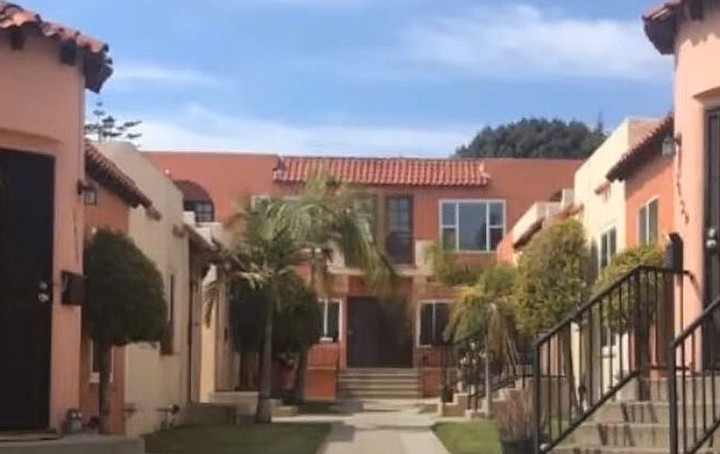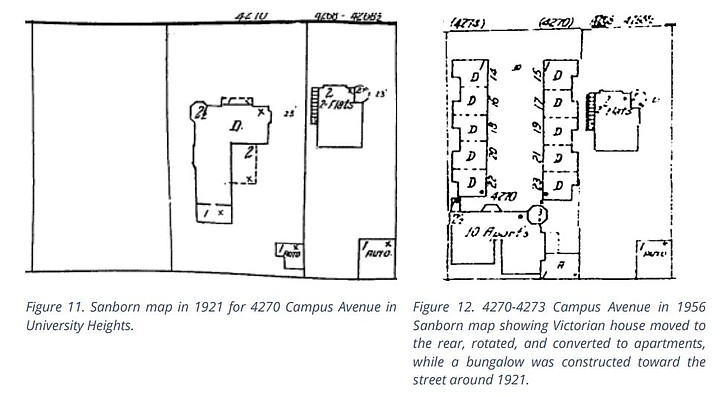 Facebook
Facebook
 X
X
 Instagram
Instagram
 TikTok
TikTok
 Youtube
Youtube

A report that could affect thousands of property owners in San Diego by bringing historic designation to some bungalow and apartment courts has sparked strong opposition and support.
What began as an informational item at a workshop last week on the draft "Bungalow Court and Apartment Court Historic Context Statement" quickly turned into a discussion about delaying it.

Opponents claimed the Historical Resources Board "tried to ram this through" with little notice, without doing a field survey to document every property or knowing its impact on the development of housing in the city's older neighborhoods, and that their methods could sweep most courtyard buildings into its wide net.
A typical bungalow court contains several small houses arranged around a central garden. But the city added in apartment courts, and broke each type into a slew of categories that include hybrid versions with styles from different periods.
"Rather terrifying," is how architect Scott Moomjian, who has spent more than 30 years working on historic properties throughout San Diego, described the report.

The city "pretty much captured all multistory family types that are one and two stories that were built throughout San Diego from 1917 to 1960," Moomjian said.
"I urge the board, this thing should not move forward."
The draft report, meant to help evaluate the buildings for possible designation, is funded by a grant from the California Office of Historic Preservation. According to staff reports, it has been in process for 10 months, but critics said the item was docketed only several weeks ago.
Now, as just 30 days are left to produce a final document, the board chose not to delay it.
Comments from the workshop won't be included in the report sent to the state, said Kelley Stanco, development project manager for Historic Preservation Planning.
Staff will go over the comments with their consultant, Page & Turnbull, an architectural firm that works on historic preservation. They'll decide how, in the short time left, the document should be amended to reflect the comments, "and address those whenever we can."
Stanco defended the board's approach, saying cultural context statements - like the LGBTQ Historic Context Statement - are more influenced by public input than architectural based ones, which are mostly shaped by field work, archival research, and review of survey data and sources.
While there was no comprehensive survey documenting all the properties, "our consultant was out in the field," studying the character-defining features of the buildings.
The city doesn't know how many associated property types are in San Diego, "but we know there are hundreds," the staff report says.
In fact, "many other multi-family property types were encountered during the research into bungalow and apartment courts," some being similar though not meeting the definition of either property type.
The historic context statement is needed to identify the most significant examples, since the only local historical information on bungalow courts was a 1988 article from the Journal of San Diego History.
San Diego's first bungalow court was built in 1917. During the 1920s boom period, a two-story version also appeared - the apartment court. Both styles featured a central landscaped area onto which units faced and were built in the architectural styles of the period.
The buildings fell out of favor in the 1960s, when the trend was for higher densities and car parking. But the iconic units with their shared greenways never lost their charm.
"Bungalow courts are an adored component of our urban landscape," said David Moty, chair of the Kensington-Talmadge planning group, one of several supporters who didn't want the board to delay.
The board made five recommendations, such as a historic context statement for multifamily housing. Another was a city-wide survey of bungalow and apartment courts to identify eligible properties.
"The initial focus can be in areas with concentrations of these building types that were not previously surveyed, such as Ocean Beach, and areas along former streetcar lines."
Stanco said they did look at some selective examples of bungalow courts in their data for uptown, North Park and Golden Hill, but "going through all of those was beyond the scope of the context statement."
There are things on that list that would meet their definition of a bungalow or apartment court, and things that would not, she said.
"So I think as we get into it, as we apply it, folks will see it's not as broad as they fear."


A report that could affect thousands of property owners in San Diego by bringing historic designation to some bungalow and apartment courts has sparked strong opposition and support.
What began as an informational item at a workshop last week on the draft "Bungalow Court and Apartment Court Historic Context Statement" quickly turned into a discussion about delaying it.

Opponents claimed the Historical Resources Board "tried to ram this through" with little notice, without doing a field survey to document every property or knowing its impact on the development of housing in the city's older neighborhoods, and that their methods could sweep most courtyard buildings into its wide net.
A typical bungalow court contains several small houses arranged around a central garden. But the city added in apartment courts, and broke each type into a slew of categories that include hybrid versions with styles from different periods.
"Rather terrifying," is how architect Scott Moomjian, who has spent more than 30 years working on historic properties throughout San Diego, described the report.

The city "pretty much captured all multistory family types that are one and two stories that were built throughout San Diego from 1917 to 1960," Moomjian said.
"I urge the board, this thing should not move forward."
The draft report, meant to help evaluate the buildings for possible designation, is funded by a grant from the California Office of Historic Preservation. According to staff reports, it has been in process for 10 months, but critics said the item was docketed only several weeks ago.
Now, as just 30 days are left to produce a final document, the board chose not to delay it.
Comments from the workshop won't be included in the report sent to the state, said Kelley Stanco, development project manager for Historic Preservation Planning.
Staff will go over the comments with their consultant, Page & Turnbull, an architectural firm that works on historic preservation. They'll decide how, in the short time left, the document should be amended to reflect the comments, "and address those whenever we can."
Stanco defended the board's approach, saying cultural context statements - like the LGBTQ Historic Context Statement - are more influenced by public input than architectural based ones, which are mostly shaped by field work, archival research, and review of survey data and sources.
While there was no comprehensive survey documenting all the properties, "our consultant was out in the field," studying the character-defining features of the buildings.
The city doesn't know how many associated property types are in San Diego, "but we know there are hundreds," the staff report says.
In fact, "many other multi-family property types were encountered during the research into bungalow and apartment courts," some being similar though not meeting the definition of either property type.
The historic context statement is needed to identify the most significant examples, since the only local historical information on bungalow courts was a 1988 article from the Journal of San Diego History.
San Diego's first bungalow court was built in 1917. During the 1920s boom period, a two-story version also appeared - the apartment court. Both styles featured a central landscaped area onto which units faced and were built in the architectural styles of the period.
The buildings fell out of favor in the 1960s, when the trend was for higher densities and car parking. But the iconic units with their shared greenways never lost their charm.
"Bungalow courts are an adored component of our urban landscape," said David Moty, chair of the Kensington-Talmadge planning group, one of several supporters who didn't want the board to delay.
The board made five recommendations, such as a historic context statement for multifamily housing. Another was a city-wide survey of bungalow and apartment courts to identify eligible properties.
"The initial focus can be in areas with concentrations of these building types that were not previously surveyed, such as Ocean Beach, and areas along former streetcar lines."
Stanco said they did look at some selective examples of bungalow courts in their data for uptown, North Park and Golden Hill, but "going through all of those was beyond the scope of the context statement."
There are things on that list that would meet their definition of a bungalow or apartment court, and things that would not, she said.
"So I think as we get into it, as we apply it, folks will see it's not as broad as they fear."
Comments